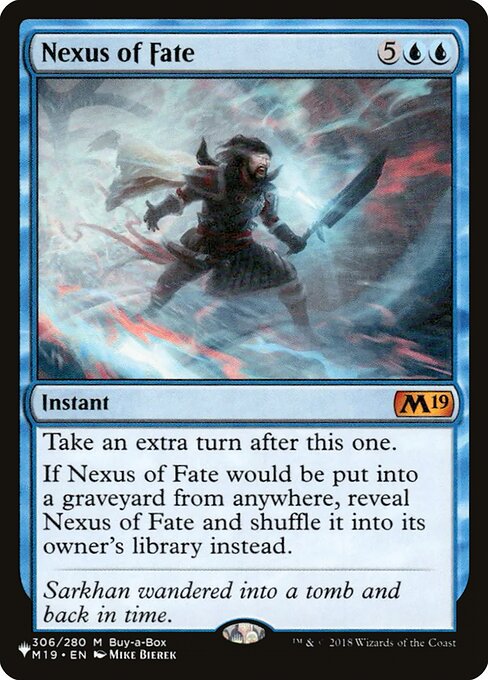
Image courtesy of Scryfall.com
Nexus of Fate in Limited Formats: Draft and Sealed Strategies
Blue tempo, late-game inevitability, and a dash of time-warp nostalgia—that's the flavor of Nexus of Fate when it wanders into a limited format. This card, a mythic reprint from The List, carries a hefty mana price of 5 colorless and 2 blue mana, totaling a 7-mana investment. Yet what it promises in effect is something many players chase in both draft and sealed: a guaranteed extra turn that can tilt the math of a late-game board state 🧙♂️💎. If it ever lands in your graveyard, the card’s text shouts, “nope, back to your library,” shuffling itself instead of languishing away. That twist—a built-in safeguard—gives Nexus of Fate a curious resilience in limited play, where graveyard hate and exile are abundant, but not always unstoppable. ⚔️🎲
What the card does and why it matters in a game of limited
At its core, Nexus of Fate is an instant that says, “Take an extra turn after this one.” That is a glow-up for control, tempo, or ramp-y blue shells, but it comes with a catch: paying seven mana for a spell that grants a single extra turn is a decision death-mroller in many limited games. The opportunity cost is real—as blue decks in drafts often rely on tempo, disruption, and card draw, a seven-mana spell can feel like a bridge too far when you're staring at early threats and removal properly distributed across both sides of the table 🔥🧙♂️.
However, the dual nature of its secondary clause—shuffle Nexus of Fate into its owner’s library instead of letting it go to the graveyard—opens unique avenues for limited decks. In practice, you want to survive long enough to cast it, then use the extra turns to push through additional spells, threaten lethal combat, or set up a policy of “draw-disrupt-draw again.” The shuffle clause means you don’t lose a potential topdeck to graveyard removal or a single unfortunate moment; you can re-draw the card later in the match and keep pressing. That effect, paired with strong blue draw engines, can let you ride the card’s power well into the late game, where a pair of extra turns can snowball into a near-impossible-to-stop win. 🧙♂️💎
Draft considerations: when to grab Nexus of Fate
- Color density matters. In a blue-heavy pool with solid curve-filling spells, Nexus of Fate becomes a legitimate pick later in the pack—someone will be able to cast it, and you want to be the one who can sustain through a protracted game. If your booster guild is light on fixers, it’s safer to pass and prioritize early plays that pressure the opponent.
- Mana acceleration is a luxury, not a given. In a typical draft, reaching 7 mana by turns 6–7 is a chore unless you’re drafting a true ramp shell or you pick up efficient mana rocks or early card draw that leads you there. If you don’t have reliable ramp or card filtering, Nexus of Fate can become a “great if I can cast it” dream rather than a consistent game plan 🎨.
- Control tools win the race. Blue control with counterspells, bounce, and cantrips buys you the time to reach seven mana and keep the opponent from pressuring you in the meantime. When you finally untap with Nexus of Fate in hand, your plan shifts from “survive” to “convert every extra turn into a threat.”
- Late-game insurance. If the draft pool contains multi-turn finishers or ways to leverage extra turns into noncombat damage or card advantage, Nexus of Fate becomes a crescendo piece. Even if you never cast it immediately, knowing it’s in your deck can influence how you play in the mid-to-late game.
Sealed format realities: a different lens
In sealed, you’re less likely to fight the curve in a vacuum; you’ll often have more stable mana and consistent access to critical spells. Nexus of Fate in a sealed pool can become a surprise finisher late in the game. The challenge is still to reach seven mana reliably, but your pool might present a smoother path with fewer competing draft choices. In practice, sealed players should evaluate Nexus of Fate as a potential single-card engine for turning the late game into a marathon—especially if the pool includes multiple card-draw or spell-retrieval options. When you untap with the ability to take an additional turn, you’re not merely extending the game; you’re inviting your opponent to wrestle with a momentum shift that blue often orchestrates best—through information, tempo, and board control. ⚔️
“Sarkhan wandered into a tomb and back in time.” This flavor line from the card’s lore capsule hints at why blue players might chase certainty in the face of unpredictability—a little time detour can reshape the battlefield. 🎨
When you’re designing a limited deck around Nexus of Fate, think of it as the “tempo anchor” that can blossom into a late-game engine. You’ll want a blueprint that includes consistent sources of card draw, protective spells, and ways to keep dangerous threats off the battlefield while you set up your seven-mana finish. If you’re drafting or opening a sealed pool with a pair of strong blue disruptors, you may want to treat this card as a potential game-ender rather than a guaranteed, early game plan. The beauty lies in the way it can turn a tense, grindy match into a stylish, time-bending finale 🧙♂️💫.
For players who enjoy the cross-promotion of content and accessories, a thoughtful desk setup can make the time spent drafting more comfortable—hence the thoughtful inclusion of ergonomic peripherals in related articles and shops. If you’re browsing content that celebrates the MTG multiverse and you’re looking to complement your playing setup, consider checking out ergonomic improvements like the Memory Foam Wrist Rest Mouse Pad—because long draft sessions deserve a comfortable throne. The matching product link is below for easy access, no matter which format you’re mastering. 🔥🎲